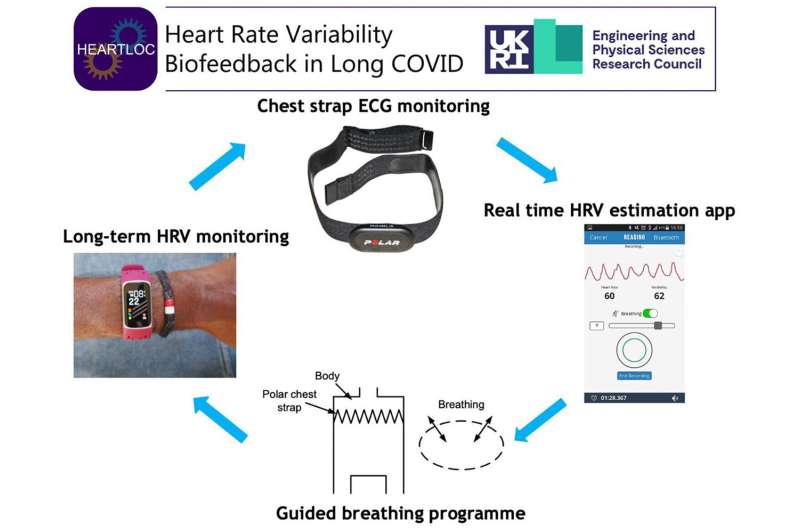This article has been reviewed according to Science X's editorial process and policies. Editors have highlighted the following attributes while ensuring the content's credibility:
fact-checked
trusted source
proofread
Long COVID: Tech assisted breathing exercises relieve symptoms

Simple breathing exercises done twice daily while using a mobile phone app can help relieve the symptoms of long COVID, new research has found.
Resonant breathing, which consists of a four second inhale and six second exhale through the nose repeated for 10 minutes, significantly improved symptoms among the 13 long COVID patients in the University of Leeds study, which is published in the journal Advances in Rehabilitation Science and Practice.
Participants used a free heart rate variability app on their mobile phones, which provided breathing guides that allowed them to track the effects of the technique. They monitored the effects using a chest strap heart rate monitor while completing the breathing exercises. Data from this, combined with heart rate data from a smart watch worn for the duration of the study, was used to analyze their progress.
After the four-week intervention, participants reported a reduction in their symptoms, better sleep and improved physical functioning.
The research was led by Dr. Manoj Sivan, Associate Professor and Consultant in Rehabilitation Medicine at the University of Leeds' School of Medicine, and research lead for the long COVID service at Leeds Community Healthcare Trust.
He said, "Long COVID can be highly debilitating, and many of the millions of patients around the world will experience pronounced disruption to employment, social and caregiving roles and participation in society.
"Developing new treatments to help these patients is vitally important. Our research suggests that resonant breathing is an easy and effective technique that can significantly improve symptoms. It requires little medical intervention, and the technology is affordable. The feedback we received from patients was overwhelmingly positive."
The participants aimed to increase their heart rate variability on the phone app while performing the breathing exercise. Heart rate variability is the variation of time between each heartbeat. A highly variable heart rate usually means that your body can adapt to many kinds of changes and better manage stress. Such a state leads to better regulation of automatic body processes like blood pressure and breathing.
A high heart rate variability is believed to reflect a state of rest and recovery, while a low heart rate variability is associated with the state of 'fight or flight' and is seen in people with anxiety, pain and fatigue.
Tracking HRV alongside breathing techniques is known as Heart Rate Variability Biofeedback (HRV-B). Previous studies of HRV-B for other chronic conditions such as asthma, depression, fibromyalgia and post-traumatic stress have shown that the optimal breathing frequency to improve symptoms is on average between 5.5 and six breaths per minute, known as resonant breathing.
HRV-B helps to restore the autonomic balance through activation of the parasympathetic nervous system, which steadies heart rate and blood pressure.
The study, which is the first to test HRV-B in long COVID, monitored participants' symptoms using several scores including the COVID-19 Yorkshire Rehabilitation Scale (C19YRS), which was developed by the same research team and is now used across NHS England.
The C19YRS results showed on average:
- A six point reduction in symptom severity out of a possible 30 points
- A two point reduction in functional disability out of a possible 15 points
- A one point increase in global health out of a possible 10 points
There was also a 10-point improvement in EQ-5D-5L VAS (quality of life measure) and an improvement in the autonomic symptoms score. The smart watch data showed improvements in patients' overall heart rate variability recorded throughout the day.
Patients also provided feedback on the effect of the technique on their symptoms at the end of the trial. Patients said they would continue with the exercises, and that the intervention helped with sleep, stress levels and increased energy to carry out daily activities.
Long COVID causes dysfunction of the autonomic nervous system, known as dysautonomia. Symptoms include fatigue, breathlessness, palpitations, dizziness, pain and brain fog.
APPROVAL TBC Dr. Joanna Corrado, specialist trainee and clinical research fellow in Leeds' School of Medicine, said, "Our study provides further evidence of long COVID and highlights the presence of dysautonomia in the condition. It also demonstrates the feasibility of a potential simple intervention that will be useful in its management."
Further research is now needed to test the technique on a larger scale and against a control group.
More information: Joanna Corrado et al, HEART Rate Variability Biofeedback for LOng COVID Dysautonomia (HEARTLOC): Results of a Feasibility Study, Advances in Rehabilitation Science and Practice (2024). DOI: 10.1177/27536351241227261

















